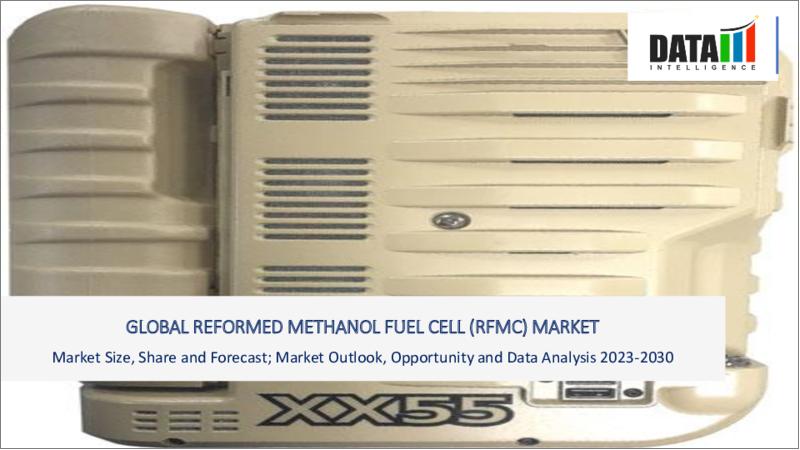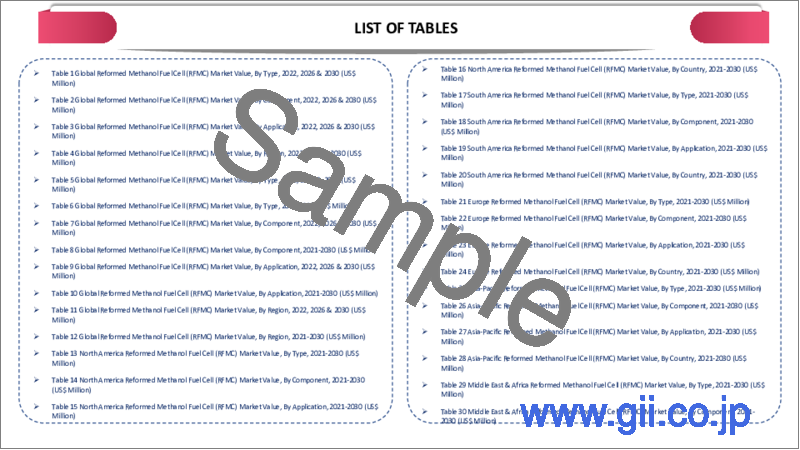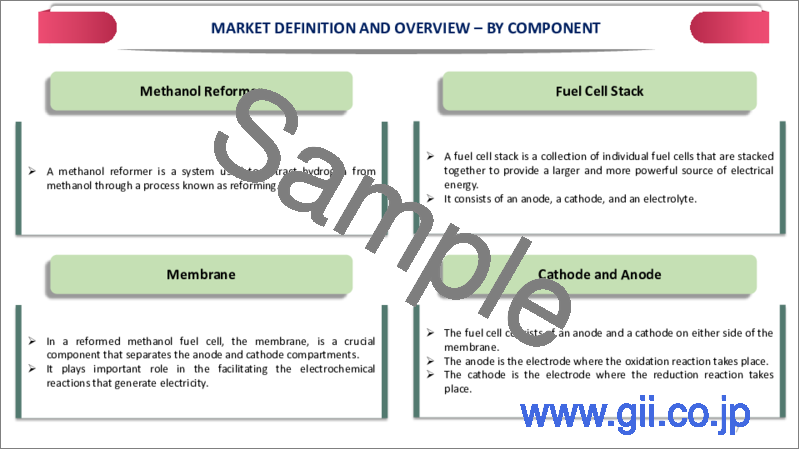|
|
市場調査レポート
商品コード
1372117
改質メタノール型燃料電池(RFMC)の世界市場-2023年~2030年Global Reformed Methanol Fuel Cell (RFMC) Market - 2023-2030 |
||||||
カスタマイズ可能
適宜更新あり
|
|||||||
| 改質メタノール型燃料電池(RFMC)の世界市場-2023年~2030年 |
|
出版日: 2023年10月18日
発行: DataM Intelligence
ページ情報: 英文 195 Pages
納期: 即日から翌営業日
|
- 全表示
- 概要
- 目次
概要
改質メタノール型燃料電池(RFMC)の世界市場は、2022年に21億米ドルに達し、2023年から2030年の予測期間にCAGR 16.2%で成長し、2030年には59億米ドルに達すると予測されています。
世界の改質メタノール燃料電池市場は、クリーンで効率的な電源に対する需要の高まりにより急成長しています。メタノールは、天然ガス、石炭、バイオマス、埋立地ガス、産業排出物など、さまざまな原料から生産することができます。原料の選択肢が多様であるため、メタノールは汎用性が高く、容易に入手可能なクリーン・エネルギー源となっています。また、メタノールはバイオマスなどの再生可能資源からも生産できるため、環境の持続可能性をさらに高め、二酸化炭素排出量を削減することができます。
メタノールは船舶に適しているため、船舶用燃料として人気を集めています。その成長の原動力となっているのは、海運業界により厳しい排出基準を課す国際的な規制の変化です。メタノールの利点には、硫黄を含まず、低排出ガスであること、船舶用蒸留燃料と比較してコスト面で有利であること、国際海事機関(IMO)のエネルギー効率設計指数(EEDI)でLNGやディーゼルと比較して高いスコアを達成していることなどがあります。このような利点により、メタノールは海運セクターにとって魅力的な選択肢となっており、市場の成長に寄与しています。
改質メタノール燃料電池市場では、アジア太平洋が最大の地域になると予想されています。メタノールは、輸送用燃料として世界的に大きな支持を得ています。Methanol Institute"の報告書によると、特に中国は、既存の自動車、トラック、バスにクリーン燃焼燃料としてメタノールを率先して使用しています。中国の輸送用燃料プール全体の約7%がメタノールです。中国では何十万台もの自動車が、ニートメタノール(M100)やM85(メタノール85%とガソリン15%の混合燃料)などの高比率メタノール燃料に転換されており、自動車セクターにおけるメタノールの受容が拡大していることを示しています。
ダイナミクス
クリーン・エネルギー需要
EVにおけるクリーン・エネルギー需要の高まりが改質メタノール燃料電池の需要を増加させる中、自動車業界は温室効果ガスの排出と汚染の削減に努め、グリーン革命を起こしつつあります。輸送、特に内燃機関を動力源とする自動車は、排出ガスに大きく寄与しています。世界各国政府は、気候変動と闘うために、よりクリーンな代替燃料の開発を推進しています。
メタノールは、改質メタノール燃料電池を含む燃料電池の開発において重要な役割を果たしています。燃料電池は水素キャリアとしてメタノールを利用するため、自動車の推進力などさまざまな用途に理想的な選択肢となります。メタノールは化学式CH3OHで表され、通常の条件下では他のどの安定した液体よりも多量の水素を含んでいます。
例えば、吉利控股グループの新エネルギー商用車ブランドであるFarizon Autoは、3つの革新的な新エネルギー製品、Farizon G純電気大型トラック、Farizon Gメタノールハイブリッド大型トラック、Farizon G改質メタノール燃料電池大型トラックを特徴とするFarizon Gトラック製品シリーズを発表しました。これらのトラックは、ファライゾンが開発した先進的なGXA-Tアーキテクチャをベースとしており、来る第19回杭州アジア競技大会での物流業務に大きく貢献するよう設計されています。
水素キャリアとしてのメタノールの利用拡大
改質メタノール型燃料電池の需要が拡大している背景には、水素キャリアとしてのメタノールがあります。メタノールは、非常に効率的な水素キャリアとして認識されており、1つのアルコール分子の中にかなりの量の水素が詰まっています。この特徴は、水素を貯蔵・輸送する実用的かつ効率的な手段となっています。気体の水素とは異なり、メタノールは常温では液体であるため、取り扱い、貯蔵、輸送が容易です。メタノールの世界の取引を支える既存のインフラを、こうした目的に活用することができます。
メタノール改質装置は、使用時にオンデマンドで水素を発生させることができます。これにより、燃料としての気体水素の貯蔵や輸送に伴うロジスティクスの複雑さや高コストを解消することができます。例えば、e1はアジアの大型トラックメーカーとの新たな提携を発表する予定です。この提携は、e1のメタノールから水素を発生させる技術をHDトラックに組み込むことに重点を置き、輸送分野におけるe1の技術の応用をさらに拡大するものと思われます。
一酸化炭素の課題への対応
改質水素燃料電池市場は、主にメタノール改質によって生成される水素中の一酸化炭素(CO)の存在に関連する改質水素燃料電池によって大きな影響を受ける可能性があります。COは、100℃以下の温度で作動するプロトン交換膜(PEM)燃料電池触媒にとって毒です。COが水素燃料中に存在すると、PEM燃料電池の性能と効率を著しく低下させる。自動車用燃料電池を含む多くの燃料電池アプリケーションは、この温度範囲で作動するため、これは重大な懸念事項です。
メタノール改質によって製造された水素をPEM燃料電池で使用するには、改質ガスを洗浄してCOを除去しなければならないです。この洗浄ステップが加わることで、プロセス全体の効率が低下します。COを除去するためにエネルギーと資源が必要となり、水素製造プロセス全体の効率が低下します。研究者たちは、燃料電池システムの性能と効率を向上させるため、改質水素中のCOを最小化または除去する解決策に積極的に取り組んでいます。
目次
第1章 調査手法と調査範囲
第2章 定義と概要
第3章 エグゼクティブサマリー
第4章 市場力学
- 影響要因
- 促進要因
- クリーンエネルギー需要
- 水素キャリアとしてのメタノールの利用拡大
- 抑制要因
- 一酸化炭素の課題への対応
- 機会
- 影響分析
- 促進要因
第5章 産業分析
- ポーターのファイブフォース分析
- サプライチェーン分析
- 価格分析
- 規制分析
- ロシア・ウクライナ戦争分析
- DMI意見
第6章 COVID-19分析
第7章 成分別
- メタノール改質器
- 燃料電池スタック
- 膜
- カソードとアノード
- バイポーラプレート
第8章 用途別
- ポータブル
- 据え置き型
- 輸送用
- 軍用車両
- その他
第9章 地域別
- 北米
- 米国
- カナダ
- メキシコ
- 欧州
- ドイツ
- 英国
- フランス
- イタリア
- ロシア
- その他欧州
- 南米
- ブラジル
- アルゼンチン
- その他南米
- アジア太平洋
- 中国
- インド
- 日本
- オーストラリア
- その他アジア太平洋地域
- 中東・アフリカ
第10章 競合情勢
- 競合シナリオ
- 市況/シェア分析
- M&A分析
第11章 企業プロファイル
- SFC Energy AG
- 会社概要
- 製品ポートフォリオと説明
- 財務概要
- 主な発展
- EFOY Pro
- SerEnergy A.S
- Blue World Technologies
- Fujikura Ltd.
- Toshiba Corporation
- Oorja Photonics Inc.
- ULTRACELL LLC
第12章 付録
Overview
Global Reformed Methanol Fuel Cell (RFMC) Market reached US$ 2.1 billion in 2022 and is expected to reach US$ 5.9 billion by 2030, growing with a CAGR of 16.2% during the forecast period 2023-2030.
The global reform methanol fuel cell market is growing rapidly due to the increasing demand for clean and efficient power sources. Methanol can be produced from various sources, including natural gas, coal, biomass, landfill gas and industrial emissions. It diversity of feedstock options makes methanol a versatile and readily available clean energy source. Methanol can also be produced from renewable resources like biomass, further enhancing its environmental sustainability and reducing its carbon footprint.
Methanol is gaining traction as a marine fuel due to its suitability for ships. It growth is driven by international regulatory changes that impose stricter emissions standards on the maritime industry. Methanol's advantages include being sulfur-free, producing low emissions, offering cost advantages compared to marine distillate fuel and achieving a higher score on the International Maritime Organization's (IMO) energy efficiency design index (EEDI) compared to LNG or diesel. The benefits make methanol an attractive option for the shipping sector, contributing to the market's growth.
Asia-Pacific is expected to be the largest region in the reformed methanol fuel cell market. Methanol has gained significant traction as a transportation fuel globally. According to the "Methanol Institute" report, China, in particular, has taken the lead in using methanol as a clean-burning fuel in its existing cars, trucks and buses. Approximately 7% of China's total transportation fuel pool is represented by methanol. The conversion of hundreds of thousands of vehicles in China to run on high-proportion methanol fuels, including neat methanol (M100) and M85 (a blend of 85% methanol and 15% gasoline), demonstrates the growing acceptance of methanol in the automotive sector.
Dynamics
Clean Energy Demand
With the growing demand for clean energy in EVs increasing the demand for reformed methanol fuel cells, the automotive industry is undergoing a green revolution as it strives to reduce greenhouse gas emissions and pollution. Transportation, particularly vehicles powered by internal combustion engines, contributes significantly to emissions. Governments globally are pushing for cleaner alternatives to combat climate change.
Methanol plays a crucial role in the development of fuel cells, including reformed methanol fuel cells. The fuel cells utilize methanol as a hydrogen carrier, making it an ideal option for various applications, including vehicle propulsion. Methanol, with its chemical formula CH3OH, contains a significant amount of hydrogen, more than any other stable liquid under normal conditions.
For instance, Farizon Auto, a new energy commercial vehicle brand under the Geely Holding Group, has introduced the Farizon G Truck Product Series featuring three innovative new energy products: the Farizon G pure electric heavy truck, the Farizon G methanol hybrid heavy truck and the Farizon G reformed methanol fuel cell heavy truck. The trucks, based on the advanced GXA-T architecture developed by Farizon, are designed to contribute significantly to logistics operations during the upcoming 19th Hangzhou Asian Games.
Expanding Use of Methanol as a Hydrogen Carrier
The growing demand for reformed methanol fuel cells can be attributed to a hydrogen carrier. Methanol is recognized as an extremely efficient hydrogen carrier, packing a significant amount of hydrogen within a single alcohol molecule. It feature makes it a practical and efficient means of storing and transporting hydrogen. Unlike gaseous hydrogen, methanol is a liquid at ambient conditions, which simplifies its handling, storage and transportation. Existing infrastructure supporting the global trade of methanol can be leveraged for these purposes.
Methanol reformers can generate hydrogen on demand at the point of use. It eliminates the complexity and high costs associated with the logistics of storing and transporting gaseous hydrogen as a fuel. For instance, e1 is set to announce a new partnership with a significant Asian vehicle manufacturer of heavy-duty (HD) trucks. It partnership is likely to focus on the integration of e1's methanol to H2-generator technology into HD trucks, further expanding the application of their technology in the transportation sector.
Addressing Carbon Monoxide Challenges
The reformed hydrogen fuel cell market can be significantly impacted by the, reformed hydrogen fuel cells primarily related to the presence of carbon monoxide (CO) in the hydrogen produced through methanol reforming. CO is a poison for proton exchange membrane (PEM) fuel cell catalysts operating at temperatures below 100 °C. When CO is present in the hydrogen fuel, it can significantly degrade the performance and efficiency of PEM fuel cells. It is a critical concern because many fuel cell applications, including automotive fuel cells, operate in this temperature range.
To use hydrogen produced through methanol-reforming in PEM fuel cells, the reformed gas must be cleaned to remove CO. It additional cleaning step reduces the overall efficiency of the process. Energy and resources are required to remove CO, making the overall hydrogen production process less efficient. Researchers are actively working on solutions to minimize or eliminate CO in reformed hydrogen to improve the performance and efficiency of fuel cell systems.
Segment Analysis
The global reformed methanol fuel cell market is segmented based on component, application and region.
Methanol Reformers: Pioneering Clean Energy in the Reformed Methanol Fuel Cell Market
Methanol reformer is the major component in the methanol-reformed fuel cell market, methanol reformers efficiently produce hydrogen gas (H2) from methanol (CH3OH) and water (H2O). It hydrogen can then be used as a clean fuel source for fuel cells to generate electricity. Methanol reformers are suitable for a variety of applications, including portable electronic devices, backup power systems, stationary power generation and transportation. Its versatility has expanded their market reach.
Ongoing research and development efforts have improved the efficiency and reliability of methanol reformers. The advancements have contributed to the growth of the methanol-reformer segment in the reformed methanol fuel cell market. Methanol can be distributed using existing fuel supply chains, making it readily available for various end-users and applications.
Geographical Penetration
Asia-Pacific's Growing Role in the Reformed Methanol Fuel Cell Market
Asia-Pacific is experiencing significant growth in the reformed methanol fuel cell market. The Chinese government has set ambitious carbon goals, including reaching carbon neutrality by 2060. To achieve these targets, China is actively exploring alternative fuels like methanol. The government's support for methanol cars and related industries demonstrates its commitment to this transition.
In 2019, the Chinese national government released a policy supporting methanol fuel, particularly in public transport, taxis and government vehicles. Local officials have also started offering subsidies to methanol car buyers and supporting gas stations in providing methanol fuel. Also, the number of EVs in region has grown significantly in the past decade, while methanol cars are still relatively limited in number.
Competitive Landscape
The major global players in the market include: SFC Energy AG, EFOY Pro, SerEnergy A.S, Blue World Technologies, Fujikura Ltd., Toshiba Corporation, Oorja photonics inc., ULTRACELL LLC.
COVID-19 Impact Analysis:
COVID-19 pandemic made a significant impact on the methanol fuel cell market, pandemic led to a significant reduction in demand for hydrogen, particularly in sectors such as oil refining, the chemical industry and steel manufacturing. The industries, which are major consumers of hydrogen, experienced disruptions and reduced production due to lockdowns and decreased economic activity. As a result, demand for key chemicals produced using hydrogen, including methanol, dropped by 7%.
Prior to the pandemic, there was strong momentum in the development and adoption of low-carbon forms of hydrogen, including hydrogen fuel-cell vehicles and electrolysis capacity. However, the crisis disrupted supply chains, delayed projects and impacted investment in these technologies. Sales of hydrogen fuel-cell vehicles and the deployment of electrolyzer capacity faced challenges, potentially slowing down the growth of these sectors.
Russia-Ukraine War Impact
The Russia-Ukraine war made a significant impact on the reformed methanol fuel cell market. The conflict in Ukraine has drawn attention to the importance of an orderly energy transition, especially in the maritime industry. With international environmental regulations becoming more stringent, there is a growing need for cleaner marine fuels and methanol is emerging as a viable option.
The Russia-Ukraine conflict has raised concerns about energy security, especially for the European Union (EU), a major buyer of Russian gas. Countries, particularly Germany, are reconsidering their reliance on cheap Russian gas and exploring alternative energy sources, including cleaner marine fuels like methanol. War has underscored the importance of an orderly energy transition, driving interest in cleaner marine fuels like methanol.
By Component
- Methanol reformer
- Fuel cell stack
- Membrane
- Cathode and anode
- Bipolar plates
By Application
- Portable
- Stationary
- Transportation
- Military Vehicle
- Others
By Region
- North America
- U.S.
- Canada
- Mexico
- Europe
- Germany
- UK
- France
- Italy
- Russia
- Rest of Europe
- South America
- Brazil
- Argentina
- Rest of South America
- Asia-Pacific
- China
- India
- Japan
- Australia
- Rest of Asia-Pacific
- Middle East and Africa
Key Developments
- In June 2023, Farizon Auto, a new energy commercial vehicle brand under Geely Holding Group, introduced three new energy heavy trucks as part of its Farizon G Truck Product Series. The trucks represent advancements in sustainable transportation. It heavy truck utilizes reformed methanol fuel cell technology, showcasing a commitment to innovative solutions in the field of new energy vehicles. It likely combines the advantages of methanol fuel cells with reformed methanol for improved efficiency and reduced emissions.
- In May 2022, Aalborg University and Blue World Technologies collaborated on a hybrid reformed methanol fuel cell system combining a methanol fuel cell and a battery for telecom power backup. With the global telecommunications industry's growing power demands, especially with 5G technology, this hybrid system aims to provide a greener and more efficient solution than traditional backup systems. Methanol fuel cells offer a practical and environmentally friendly approach to ensure network stability.
- In July 2023, German fuel cell supplier SFC Energy (SFC) initiated the production of hydrogen and methanol fuel cells at its manufacturing facility in New Delhi/Gurgaon, India. It development underscores the growing importance of fuel cell technology and its role in decarbonizing industry and energy production, particularly in the context of India's sustainable manufacturing goals.
Why Purchase the Report?
- To visualize the global reformed methanol fuel cell market segmentation based on component, application and region, as well as understand key commercial assets and players.
- Identify commercial opportunities by analyzing trends and co-development.
- Excel data sheet with numerous data points of reformed methanol fuel cell market-level with all segments.
- PDF report consists of a comprehensive analysis after exhaustive qualitative interviews and an in-depth study.
- Product mapping available as excel consisting of key products of all the major players.
The global reformed methanol fuel cell market report would provide approximately 48 tables, 49 figures and 195 Pages.
Target Audience 2023
- Manufacturers/ Buyers
- Industry Investors/Investment Bankers
- Research Professionals
- Emerging Companies
Table of Contents
1. Methodology and Scope
- 1.1. Research Methodology
- 1.2. Research Objective and Scope of the Report
2. Definition and Overview
3. Executive Summary
- 3.1. Snippet by Component
- 3.2. Snippet By Application
- 3.3. Snippet by Region
4. Dynamics
- 4.1. Impacting Factors
- 4.1.1. Drivers
- 4.1.1.1. Clean Energy Demand
- 4.1.1.2. Expanding the Use of Methanol as a Hydrogen Carrier
- 4.1.2. Restraints
- 4.1.2.1. Addressing Carbon Monoxide Challenges
- 4.1.3. Opportunity
- 4.1.4. Impact Analysis
- 4.1.1. Drivers
5. Industry Analysis
- 5.1. Porter's Five Force Analysis
- 5.2. Supply Chain Analysis
- 5.3. Pricing Analysis
- 5.4. Regulatory Analysis
- 5.5. Russia - Ukraine War Analysis
- 5.6. DMI Opinion
6. COVID-19 Analysis
- 6.1. Analysis of COVID-19
- 6.1.1. Scenario Before COVID
- 6.1.2. Scenario During COVID
- 6.1.3. Scenario Post COVID
- 6.2. Pricing Dynamics Amid COVID-19
- 6.3. Demand-Supply Spectrum
- 6.4. Government Initiatives Related to the Market During Pandemic
- 6.5. Manufacturers Strategic Initiatives
- 6.6. Conclusion
7. By Component
- 7.1. Introduction
- 7.1.1. Market Size Analysis and Y-o-Y Growth Analysis (%), By Component
- 7.1.2. Market Attractiveness Index, By Component
- 7.2. Methanol Reformer*
- 7.2.1. Introduction
- 7.2.2. Market Size Analysis and Y-o-Y Growth Analysis (%)
- 7.3. Fuel Cell Stack
- 7.4. Membrane
- 7.5. Cathode and Anode
- 7.6. Bipolar Plates
8. By Application
- 8.1. Introduction
- 8.1.1. Market Size Analysis and Y-o-Y Growth Analysis (%), By Application
- 8.1.2. Market Attractiveness Index, By Application
- 8.2. Portable*
- 8.2.1. Introduction
- 8.2.2. Market Size Analysis and Y-o-Y Growth Analysis (%)
- 8.3. Stationary
- 8.4. Transportation
- 8.5. Military Vehicle
- 8.6. Other
9. By Region
- 9.1. Introduction
- 9.1.1. Market Size Analysis and Y-o-Y Growth Analysis (%), By Region
- 9.1.2. Market Attractiveness Index, By Region
- 9.2. North America
- 9.2.1. Introduction
- 9.2.2. Key Region-Specific Dynamics
- 9.2.3. Market Size Analysis and Y-o-Y Growth Analysis (%), By Component
- 9.2.4. Market Size Analysis and Y-o-Y Growth Analysis (%), By Application
- 9.2.5. Market Size Analysis and Y-o-Y Growth Analysis (%), By Country
- 9.2.5.1. U.S.
- 9.2.5.2. Canada
- 9.2.5.3. Mexico
- 9.3. Europe
- 9.3.1. Introduction
- 9.3.2. Key Region-Specific Dynamics
- 9.3.3. Market Size Analysis and Y-o-Y Growth Analysis (%), By Component
- 9.3.4. Market Size Analysis and Y-o-Y Growth Analysis (%), By Application
- 9.3.5. Market Size Analysis and Y-o-Y Growth Analysis (%), By Country
- 9.3.5.1. Germany
- 9.3.5.2. UK
- 9.3.5.3. France
- 9.3.5.4. Italy
- 9.3.5.5. Russia
- 9.3.5.6. Rest of Europe
- 9.4. South America
- 9.4.1. Introduction
- 9.4.2. Key Region-Specific Dynamics
- 9.4.3. Market Size Analysis and Y-o-Y Growth Analysis (%), By Component
- 9.4.4. Market Size Analysis and Y-o-Y Growth Analysis (%), By Application
- 9.4.5. Market Size Analysis and Y-o-Y Growth Analysis (%), By Country
- 9.4.5.1. Brazil
- 9.4.5.2. Argentina
- 9.4.5.3. Rest of South America
- 9.5. Asia-Pacific
- 9.5.1. Introduction
- 9.5.2. Key Region-Specific Dynamics
- 9.5.3. Market Size Analysis and Y-o-Y Growth Analysis (%), By Component
- 9.5.4. Market Size Analysis and Y-o-Y Growth Analysis (%), By Application
- 9.5.5. Market Size Analysis and Y-o-Y Growth Analysis (%), By Country
- 9.5.5.1. China
- 9.5.5.2. India
- 9.5.5.3. Japan
- 9.5.5.4. Australia
- 9.5.5.5. Rest of Asia-Pacific
- 9.6. Middle East and Africa
- 9.6.1. Introduction
- 9.6.2. Key Region-Specific Dynamics
- 9.6.3. Market Size Analysis and Y-o-Y Growth Analysis (%), By Component
- 9.6.4. Market Size Analysis and Y-o-Y Growth Analysis (%), By Application
10. Competitive Landscape
- 10.1. Competitive Scenario
- 10.2. Market Positioning/Share Analysis
- 10.3. Mergers and Acquisitions Analysis
11. Company Profiles
- 11.1. SFC Energy AG*
- 11.1.1. Company Overview
- 11.1.2. Product Portfolio and Description
- 11.1.3. Financial Overview
- 11.1.4. Key Developments
- 11.2. EFOY Pro
- 11.3. SerEnergy A.S
- 11.4. Blue World Technologies
- 11.5. Fujikura Ltd.
- 11.6. Toshiba Corporation
- 11.7. Oorja Photonics Inc.
- 11.8. ULTRACELL LLC
LIST NOT EXHAUSTIVE
12. Appendix
- 12.1. About Us and Services
- 12.2. Contact Us





